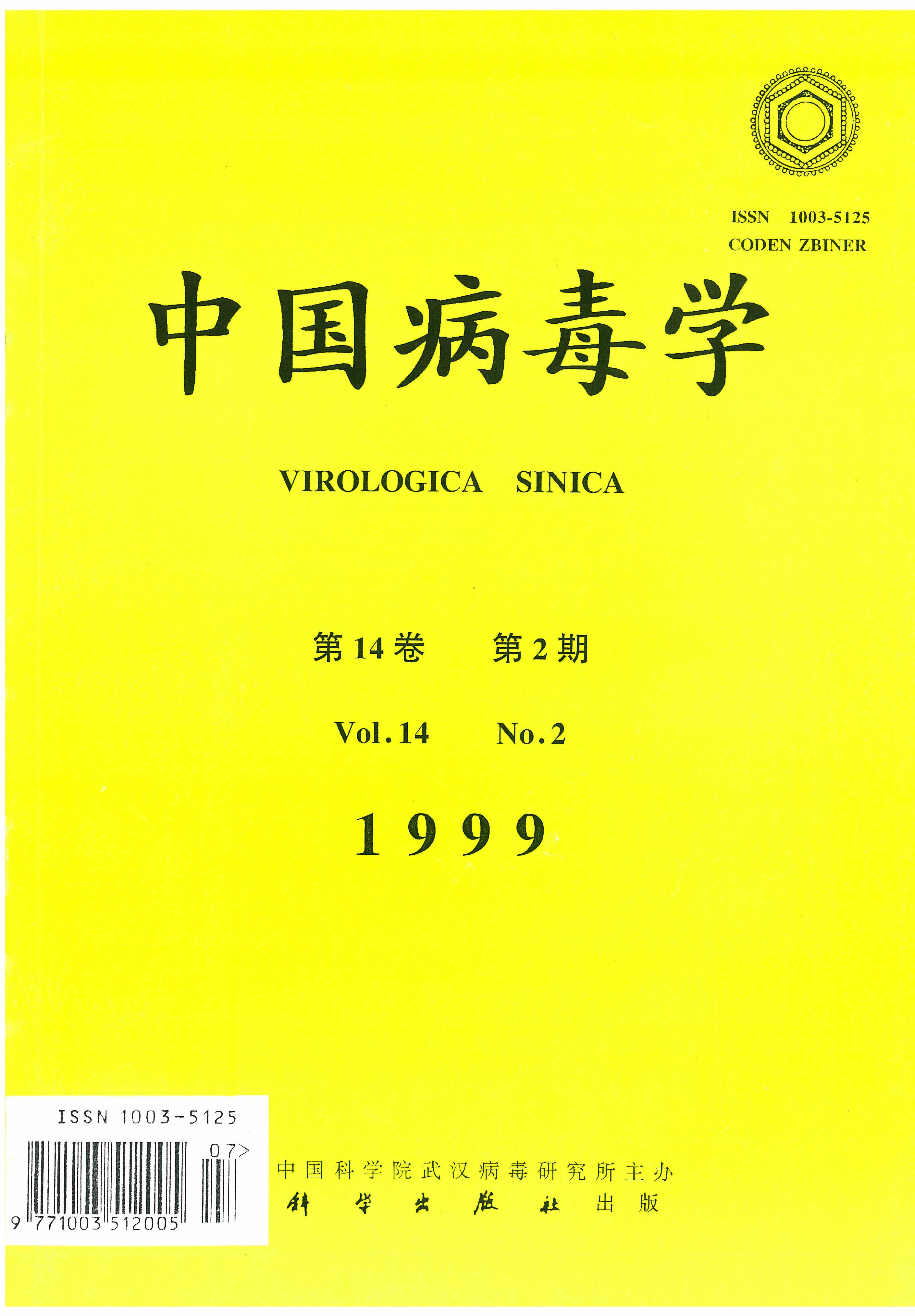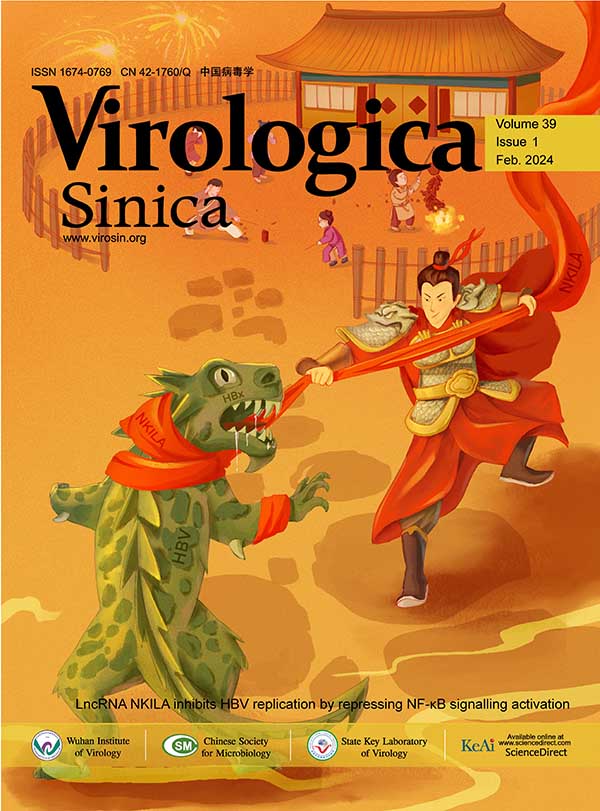The dynamic change of coxsackie B virus(CBV)5 type propagation was studied in Hep一2 cells by immunofluorescence assay,reverse transcription polymerase chain reaction and cy
tological methods The results showed that CBV RNA muld be detected at 4 hours in postinfec
tion,vira1 antigen was positive at 8 hours and cytopathic effect could be found at 12 hours The
vira1 particles could be observed at 20 hours in postinfeedon These results provided new data for
observation of CBV propagation,also,it indicated that the reverse transcription polymerase chain
reaction was a sensitive technique for m onitoring CBV propagation
The S genome segment encoding the nucleocapsid protein (truncated) of Hantavirus H8205 was amplified by PCR and cloned into the expression vector pGEX 3X and expressed in E coli. SDS PAGE showed that the expressed fusion protein (GST NP) was mainly in the form of inclusion body. The expressed protein was used as diagnostic antigen in solid phase enzyme immunoassay. The assay was used to detect IgG and IgM antibody in sera of HFRS patients originated from different geographic regions of China. The results revealed highly sensitive and specific. The successful expression and application of recombinant nucleocapsid protein of Hantavirus provides cheap, safe and sensitive antigen for the diagnosis of HFRS in China.
For investigating poliovirus recombinant defective vector system, the separated genes of poliovirus structure protein and replicase were induced into cell, the defective recombinant virus could be assembled. This virus is able to infect the cell and to express the extraneous gene in the cell, and, no filial virus would be produced. The transient expression system has been established in this work for investigating the applied technique of poliovirus defective recombinant system in gene transduction.
Torch is the abbreviation of four pathgenic microbols: Tonoplasma gondic (Toxo), Rubella Virus (RuV), Cytomegalovirus (CMV), and Herpes Simplex Virus (HSV 1 2 ). A new indirect ELISA reagent to detect the specific IgG and IgM antibody to ToRCH has been prepared. McAbs, labeled with horseradish peroxidase, against human IgG and IgM are used as the second antibodies. Purified Toxo, RuV, CMV, HSV 1 2 are used as antigens to coat wells. The reagent's quality has been tested. The result showed that the reagent has high specificity and low background. The sensitivity is up to 1∶160~640, the precision is high and the coefficient of variation (C.V) is between 1.4%~9.0%. The reagent is stable (stored at 37 ℃ for 4 days, the change range of each target is no more than 15%).
Three rhesus monkeys ( Macaca mulatta ) were inoculated intravenously with fecal suspensions obtained from hepatitis E patients. The alanine aminotransferase (ALT) level in the three monkeys elevated 3 to 4 weeks after infection. Virus like particles about 27 to 34 nm were found in the stool specimens, the liver and the gallbladder tissues by electron microscope examination. The liver tissue slice showed characteristic histopathologic changes of acute hepatitis. Specific HEV fragments were obtained by RT nPCR from feces and sera. Excretion of virus began on the 7th day and lasted to about the 50th day after infection. The appearance of virus in serum was 2 weeks after inoculation and lasted for only 1 to 2 weeks. Anti HEV IgG was detected by enzyme linked immunosorbent assay 3-4 weeks after infection and negative conversion took place 4 to 5 months later.
Hepatitis G virus E2 glycoprotein gene was amplified by polymerase chain reaction, and was inserted into baculovirus expression vector pF AST B AC HTa, constructing a recombinant transposing vector pF AST B AC E2. The plasmid pF AST B AC E2 was transformed into DH10B AC competent E. coli cells. High molecular weight DNA was prepared from the overnight cultures from the selected E. coli colonies, which was recombinant baculovirus shuttle vector containing HGV E2 gene, named Bacmid E2. The Bacmid E2 was transfected into Spodoptera fragiperda (Sf9) cells to get the recombinant virus. Fresh insect Sf9 cells and larvae of Spodoptera exigua were infected with the recombinant virus to express the target protein. The E2 glycoprotein recovering from the Sf9 cells and hemolymph cells of larvae of Spodoptera exigua exhibited a molecular mass of approximataly 54000D. Purified HGV E2 glycoprotein using affinity chromatography was used to develop an ELISA for detection of HGV E2
The apoptosis induced by influenza virus in cultured MDCK cells was reported and the selective inhibitory effect of melamin on the apoptosis induced by influenza virus was investigated. The results showed that the DNA ladder could be first detected at 6 h post infection (p.i.), accompanied by nuclear condensation and nuclear fragmentation could be easily detected at 12 h p.i. In addition, the apoptosis induced activity of influenza virus A1/Jingfang 86 1 strain was more potent than that of B/Hufang 93 1 strain (P0.05). In the range of 20-125 g/mL, melanin was found to significantly (P0.001) inhibit apoptosis induced by 64 hemagglutination unit influenza virus infection with a inhibitory rate comparable to that obtained by virazole and showed no cytotoxicity. The inital results suggested that the mechanism of melanin against the apoptosis induced by influenza virus was related to the blockage of viruses' adsorbtion to the host cells.
The sequences of HGV gene that had been reported were checked and analyzed. After comparison of HGV seqences from different virus strains, a gene fragment of 31 nucleotides (7121-7152 nt) served as a probe was labeled by fluorescein N 6 dd ATP with terminal transferase. The specificity of HGV probe was tested by dot blot hybridization with HCV RNA related virus RNA, C.T DNA, HGV RNA, and Southern blot hybridization with RT PCR product of HGV. Positive results obstained only from the HGV RNA of positive sera that was confirmed by nested RT PCR, all others were negative. The sensitivity of fluorescein labeled probe was examined. The result showed that the fluorescein labeled probe was able to check1.56 pg of target genome. The conformity of HGV RNA detection using RT PCR and HGV gene probe was 97.9% . The experiment suggested that fluorescein labeled probe can be used in clinic detection and epidemic study.
An infectious genome of the Periplanta fuliginosa densovirus (PfDNV) has been cloned into the bacterial plasmid pUC119. The viral genome could be rescued from the recombinant plasmid PfNDV pUC119 by transfection to sensitive Periplanta fuliginosa larvae. Virions can be found in the cells of the transfected larvaes by electron microscope, and the rescued virions were as infectious as wild type virions. In contrast, the viral genome could not be rescued from the recombinant plasmid deleted one extremity.
A couple of CSFV specific primer(PF 5648 and PR 6604)was designed with the aid
of computer primer designation software and synthesized based upon the relative conserved regions
of published sequenL-~s of C strain.NS2-3 gene(p125 gene)fragment of CSFV Shimen strain was
amplified successfu~y by RT-PCR from the anticoagulant blood of infected pig. The product
length is 957 bp,located in the central of NS3,a putative NTPase and helicase domain.The ob
tained PCR product was cloned and then sequenced.The sequence showed that this fragment con
tained all of seven typical consexved segments of helicase superfamily, including two common
N11Pbinding motifs,namely,Asite(GXGKT/S)andBsite(3hy,2x)D.Sequence ho
mology analysis revealed that Shimen strain had the highest homology wi th Japanese strains(ALD
and GPE ),and slightly lower homology with other three CSFV strains (C.Brescia and AI
fort).Shimen strain had also significant homology with two BVDV strains (NADL and SD-1)
The deduced amino acid sequence homology of Shimen strain with five CSFV and two BVDV
strains was all upper than 90% .It is further confirmed that this fragment is the most co nserved
in pestivirns amino acid sequence It is cons istent with its essential function in replication and
trans lation of virus genome and in processing of polypmtein precursor
The envelope glycoprotein E0 gene of hog cholera virus (HCV) strain C was amplified from total RNA extracted from HCV strain C infected rabbit spleen by reverse transcription and nested PCR. The PCR product was cloned into pGEM T vector. Nucleotide sequencing was performed using an ABI PRISM sequencing device. Based on the incorporation of fluorescence labelled dideoxynuclotide teminators, the sequence was compared with HCV strain C sequenced by Moormann et al . The result showed that their homologies on nucleotide and amino acid sequences were 99.08% and 98.42%, respectively.
The cellular tota1 RNA was isolated from 1ivers of the died giant panda.then the tern
plates were produced by reverse transcription reaction.Two couple primers were applied to ampli
fy the 3 end of fusion protein gene of canine distemper virus(CDV)giant panda strain About
620 bp and 780 bp fragments were amplified .The fragments were purified and sequenced There
were 693 base pairs in the 3 end of fusion protein gene of CDV gian t panda strain.Its homology
with CDV vaccine attenuated strain, CDV Onderstepoort attenuated strain, phocine distempe r
virus type 2(PDV一2)and phocine distemper virus type 1(PDV一1)in nucleotide and amino acid
were 97 5% an d 96.2% ,88.6% and 94.5% ,92.9% an d 95.6% .63.2% and 76 5% .re
spe ctiveIy.The hydmpathy profile and the second structure of the fusion protein gene in the 3
end of CDV giant panda strain were different from other strains.The numbers of the nonenco d
ing region nucleotides of CDV giant panda strain were 9 nucleotides 1onger than CDV Onder
stepeort strain in the same region.There were on@ 17 nucletidea homology in the lastest 3 end
58 bp between the two CDV strains.
The coding region of S genorae segment of Hantaan virus(76/118 strain)was inserted
into the eukarytic expression plasmld pVR1012 The recombinant expression plasmid pVRS22
was c。nstructed.Ver0一E cells were transiently tmnsfected in vitro with pVRS22 plasmid.The
transient expresslon of Hantaan virus nucleocapsid proteins in Vero-E6 cells was detected by indi
rect immunofluorescence asay(IFA)with monoclonal antibody 5H5 against Hantaan virus

















